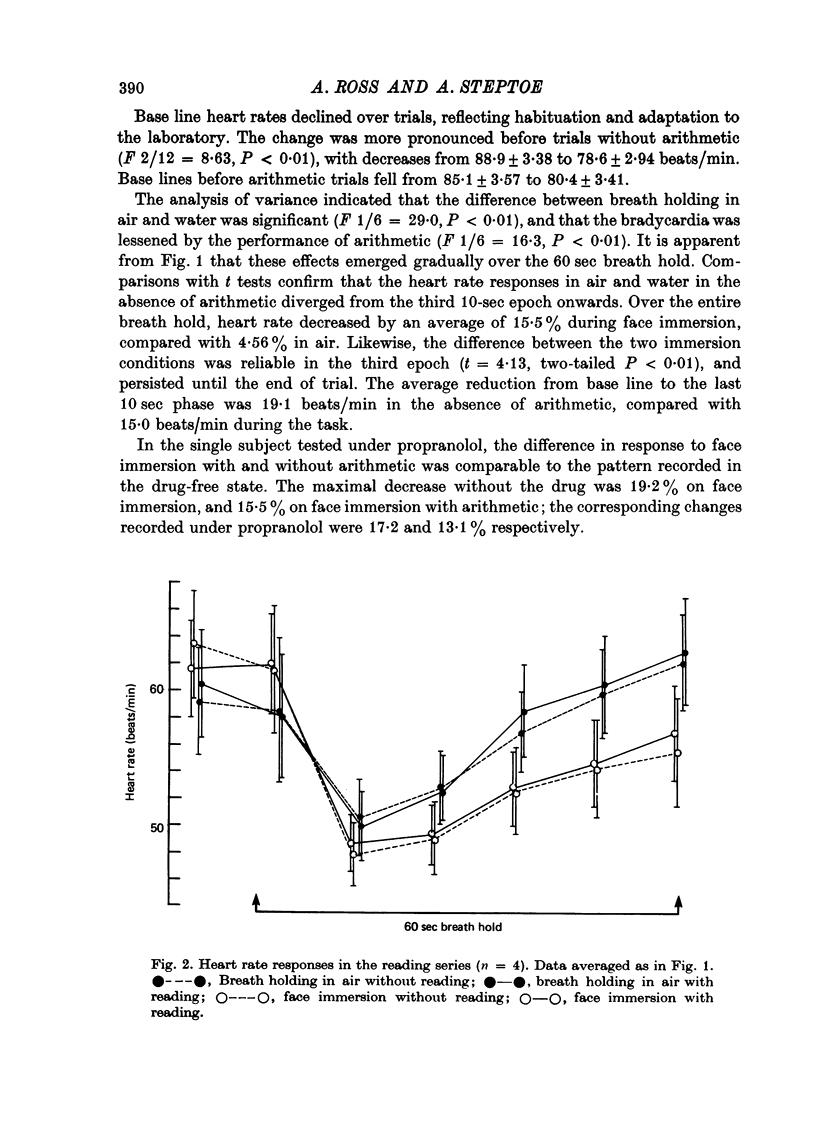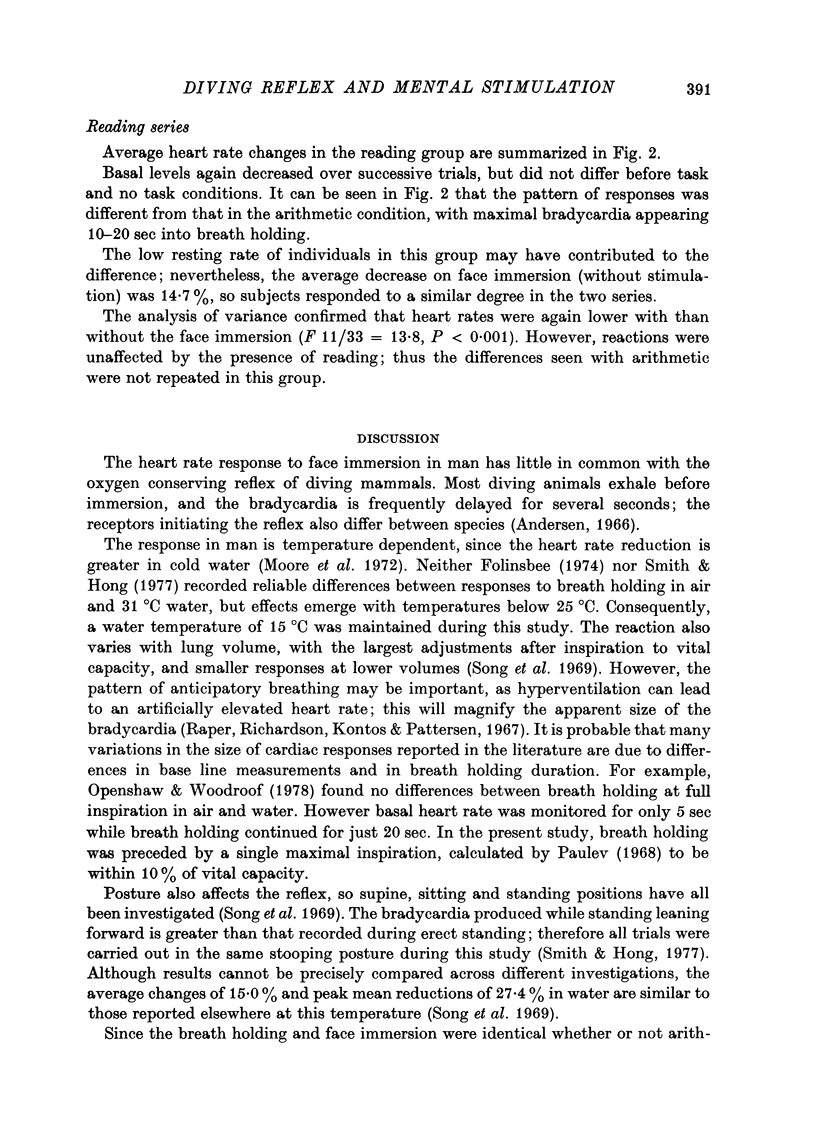Abstract
1. A study was made of the effects of mental arithmetic, and of listening to prose, on the bradycardia produced by breath holding with and without immersion of the face in cold water. 2. Bradycardia was produced in both air and water, but the response was significantly greater on face immersion. The reaction was attenuated by mental arithmetic in both air and water. In contrast external distraction by listening to prose had no effect on cardiac response. 3. It was concluded that the diving reflex can be modified by higher nervous stimulation. The effect is apparently dependent on mental challenge, such as that provoked by arithmetic.
Full text
PDF






Selected References
These references are in PubMed. This may not be the complete list of references from this article.
- Andersen H. T. Physiological adaptations in diving vertebrates. Physiol Rev. 1966 Apr;46(2):212–243. doi: 10.1152/physrev.1966.46.2.212. [DOI] [PubMed] [Google Scholar]
- BROD J., FENCL V., HEJL Z., JIRKA J. Circulatory changes underlying blood pressure elevation during acute emotional stress (mental arithmetic) in normotensive and hypertensive subjects. Clin Sci. 1959 May;18:269–279. [PubMed] [Google Scholar]
- DELGADO J. M. Circulatory effects of cortical stimulation. Physiol Rev Suppl. 1960 Apr;4:146–178. [PubMed] [Google Scholar]
- Daly M. B., Korner P. I., Angell-James J. E., Oliver J. R. Cardiovascular-respiratory reflex interactions between carotid bodies and upper-airways receptors in the monkey. Am J Physiol. 1978 Mar;234(3):H293–H299. doi: 10.1152/ajpheart.1978.234.3.H293. [DOI] [PubMed] [Google Scholar]
- Folinsbee L. Cardiovascular response to apneic immersion in cool and warm water. J Appl Physiol. 1974 Feb;36(2):226–232. doi: 10.1152/jappl.1974.36.2.226. [DOI] [PubMed] [Google Scholar]
- Gebber G. L., Klevans L. R. Central nervous system modulation of cardiovascular reflexes. Fed Proc. 1972 Jul-Aug;31(4):1245–1252. [PubMed] [Google Scholar]
- Goodwin G. M., McCloskey D. I., Mitchell J. H. Cardiovascular and respiratory responses to changes in central command during isometric exercise at constant muscle tension. J Physiol. 1972 Oct;226(1):173–190. doi: 10.1113/jphysiol.1972.sp009979. [DOI] [PMC free article] [PubMed] [Google Scholar]
- HOFF E. C., KELL J. F., Jr, CARROLL M. N., Jr Effects of cortical stimulation and lesions on cardiovascular function. Physiol Rev. 1963 Jan;43:68–114. doi: 10.1152/physrev.1963.43.1.68. [DOI] [PubMed] [Google Scholar]
- Hilton S. M. Ways of viewing the central nervous control of the circulation--old and new. Brain Res. 1975 Apr 11;87(2-3):213–219. doi: 10.1016/0006-8993(75)90418-7. [DOI] [PubMed] [Google Scholar]
- Kawakami Y., Natelson B. H., DuBois A. R. Cardiovascular effects of face immersion and factors affecting diving reflex in man. J Appl Physiol. 1967 Dec;23(6):964–970. doi: 10.1152/jappl.1967.23.6.964. [DOI] [PubMed] [Google Scholar]
- Moore T. O., Lin Y. C., Lally D. A., Hong S. K. Effects of temperature, immersion, and ambient pressure on human apneic bradycardia. J Appl Physiol. 1972 Jul;33(1):36–41. doi: 10.1152/jappl.1972.33.1.36. [DOI] [PubMed] [Google Scholar]
- Obrist P. A. Presidential Address, 1975. The cardiovascular-behavioral interaction--as it appears today. Psychophysiology. 1976 Mar;13(2):95–107. doi: 10.1111/j.1469-8986.1976.tb00081.x. [DOI] [PubMed] [Google Scholar]
- Openshaw P. J., Woodroof G. M. Effect of lung volume on the diving response in man. J Appl Physiol Respir Environ Exerc Physiol. 1978 Nov;45(5):783–785. doi: 10.1152/jappl.1978.45.5.783. [DOI] [PubMed] [Google Scholar]
- Paulev P. E. Cardiac rhythm during breath-holding and water immersion in man. Acta Physiol Scand. 1968 May-Jun;73(1):139–150. doi: 10.1111/j.1748-1716.1968.tb04091.x. [DOI] [PubMed] [Google Scholar]
- Raper A. J., Richardson D. W., Kontos H. A., Patterson J. L., Jr Circulatory responses to breath holding in man. J Appl Physiol. 1967 Feb;22(2):201–206. doi: 10.1152/jappl.1967.22.2.201. [DOI] [PubMed] [Google Scholar]
- Smith R. M., Hong S. K. Heart rate response to breath holding at 18.6 ATA. Respir Physiol. 1977 Jun;30(1-2):69–79. doi: 10.1016/0034-5687(77)90022-6. [DOI] [PubMed] [Google Scholar]
- Song S. H., Lee W. K., Chung Y. A., Hong S. K. Mechanism of apneic bradycardia in man. J Appl Physiol. 1969 Sep;27(3):323–327. doi: 10.1152/jappl.1969.27.3.323. [DOI] [PubMed] [Google Scholar]
- Steptoe A., Mathews A., Johnston D. The learned control of differential temperature in the human earlobes: preliminary study. Biol Psychol. 1974;1(3):237–242. doi: 10.1016/0301-0511(74)90015-5. [DOI] [PubMed] [Google Scholar]
- Williams R. B., Jr, Bittker T. E., Buchsbaum M. S., Wynne L. C. Cardiovascular and neurophysiologic correlates of sensory intake and rejection. I. Effect of cognitive tasks. Psychophysiology. 1975 Jul;12(4):427–433. doi: 10.1111/j.1469-8986.1975.tb00017.x. [DOI] [PubMed] [Google Scholar]
- Wolf S., Schneider R. A., Groover M. E. Further studies on the circulatory and metabolic alterations of the oxygen-conserving (diving) reflex in man. Trans Assoc Am Physicians. 1965;78:242–254. [PubMed] [Google Scholar]


